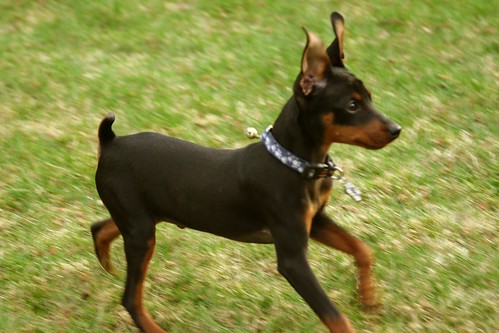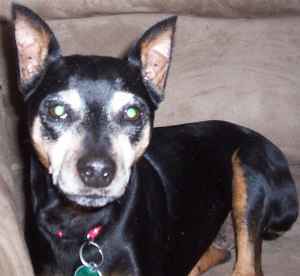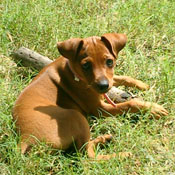 So You Think You Want a Miniature Pinscher?
So You Think You Want a Miniature Pinscher?
Why I Love Miniature Pinschers
Miniature pinschers (affectionately known as min pins) are the greatest breed of dog on earth. They are graceful, charming, funny, smart, and endearing. I have happened to be lucky enough to own the three greatest miniature pinschers on earth, except yours of course. Seriously, min pins are great dogs, but I do like all dogs. However, it’s the min pin that has stolen my heart. Having spent over 13 years with miniature pinschers in my life, I have come to understand what the AKC miniature pinscher description (Meet the Breeds) means in real-world terms, and I want to share my experiences with you. This way, you can know both the joys and challenges of owning this feisty breed of dog and decide if the min pin is a match for your family.
Photo Credit: © Min Pin Mania 2013 Creative Commons Attribution
-
Miniature Pinscher Temperament
- Fearless animation
- Complete self-possession
- Spirited Presence
Temperament
Important Considerations
I chose to discuss temperament first because I think it should be one of the first considerations when choosing a dog, and the min pin temperament represents unique challenges (and rewards). Below are is the AKC definition of a min pin’s temperament with real world examples.
- AKC Breed Standard: Fearless animation, complete self-possession, spirited presence: Miniature pinschers, like many small dogs, do not know that they are small, and they will take on big challenges. Because miniature pinschers are avid hunters, they could catch prey bigger than they are! (At least, mine have.) In addition, miniature pinschers have confidence in abundance and typically have two gears: on and off.
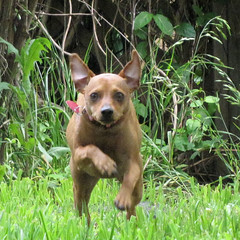 Photo: © Min Pin Mania 2013 Creative Commons Attribution
Photo: © Min Pin Mania 2013 Creative Commons Attribution
- AKC ‘Meet the Breeds’ Description: Quick and active, with a lively curiosity Quick and active is an understatement. When your min pin is in a hurry, the most you will see go by is a blurry streak. Because they are so quick, they can catch a wide variety of prey: squirrels, mice, and moles, to name a few. They are also capable of dodging you when you try to catch them. In fact they may think “dodge the human” is a fun game.This is not a good scenario when they are out in the street. I think “lively curiosity” refers to the fact that they will get into anything. If you get a min pin, you will learn to keep your possessions out of reach or have them destroyed. I have learned (the hard way) to keep the cord to my CPAP machine put away. For those of you not familiar with sleep apnea, a CPAP cord is a plastic hose with a headpiece made of highly chewable silicon. It is especially important to put away things harmful to your min pin, like medicine bottles.
Size
Big Dog Attitude in a Small Package
Miniature pinschers, as the name implies, are small in size: about 10 to 12 1/2 inches in height. AKC breed standard says that they should be about 11 to 11 1/2 inches at the withers (highest point on the shoulder blades). Miniature pinschers are square dogs; this means that their body length should equal their height (males) or slightly longer (females).
Because min pins are small, they are often recommended for people who live in apartments. While min pins can be very happy in an apartment, they will still need a fair amount of exercise. This can be accomplished with walks or active play in the apartment. While their exercise may not take much space, exercise is very important for this energetic breed and will take time.
Coat and Color
Colors Recognized by AKC
Coat and Grooming: The coat is smooth to the eye and touch. Hairs are short. In addition, the miniature pinscher doesn’t exude much oil from its skin. Thus, miniature pinschers do not require much grooming, and frequent bathing can dry their skin. The main grooming to be done is trimming their toe nails.
The following miniature pinscher coat colors are recognized by AKC:
- Solid clear red
- Stag red (red with intermingling of black hairs)
- Black and rust
- Chocolate and rust
-
Some coat colors are associated with a hereditary skin disorder
Blue and Fawn Miniature
Pinschers are Prone to
Blue and fawn (dilute black and dilute chocolate, respectively) coat colors are genetically associated with a skin condition called “color dilution alopecia” and are not recognized by AKC. See the Color Dilution Alopecia post for details.
Min Pin Body and Gait
Some Physical Features that Distinguish Miniature Pinschers
This is a non-comprehensive list of physical features that distinguish miniature pinschers from other breeds.
- Compact. Miniature pinschers are small, but every ounce of their little bodies are full of impact. Compact in the AKC definition is firmly joined union of various body parts.
- Hackney-like gait: A high lifting of the front feet accompanied by flexing of the wrist like that of a hackney horse. The hackney-like gait of the miniature pinscher makes the min pin look as if it is prancing. This just enhances the proud attitude of the miniature pinscher. It’s hard not to laugh when a min pin has a “treasure” (e.g., prey it has caught, a toy it has stolen, etc.) and prances around the yard.
- Short-coupled: In AKC terms, coupling refers to the part of the body between the ribs and the pelvis/hindquarters; the loin.
Is a Miniature Pinscher a Good Fit for Your Family?
Family Environment Makes a Difference
That your new puppy fit into your lifestyle is of the utmost importance. Several factors influence in what situations miniature pinschers do well. These include (but are definitely not limited to) space available, age of family members, activity level of the family, time and patience for training.
- Space available. As discussed earlier, space may or may not be an issue. If you are able to engage in active play or go for long walks, apartment life will suit a min pin quite well. If not, a miniature pinscher must have enough space and attention to burn off it’s energy, which min pins have in abundance.
- Young family members. First, remember that young children, especially babies and infants, should never be left alone with any dog, regardless of the age, temperament, or breed of the dog. That being said, miniature pinschers can be great with children. Miniature pinschers are sturdy dogs; however, they do have a fine bone structure, and cannot tolerate as rough play like bigger dog breeds can. Thus, play with young children should be supervised for the safety of both the children and the dog. Older children should be instructed so that they can play safely and not injure the dog.
- Older family members. Miniature pinschers can live as long as 18 to 20 years, and people often have many changes in lifestyle over this time frame. Min pins are high energy, and will probably jump, run, and insist to be played with, especially in its younger years. Many older adults don’t like a dog jumping in their lap or wanting to play fetch for hours on end. Walks could also be limited. This could make it difficult to get in the min pin’s exercise requirements. However, if the situation allows, a min pin can be a great companion for an older person.
- Activity level of the family. As discussed several times in this post, miniature pinschers are high energy. I can’t emphasize this enough. This characteristic is one of our favorite traits of the miniature pinscher breed. The energy min pins bring to our household add excitement, fun, and joy to our lives. Thus, a miniature pinscher is a good fit for a family with an active lifestyle.
- Time and patience for training. When we adopted Zeus, our first miniature pinscher, we knew that min pins were smart. We thought that would make training easy. Silly us. It can, in fact, also make training more difficult. In addition to intelligence, miniature pinschers are stubborn, willful, and independent thinkers. Instead of coming when called, a miniature pinscher, even when it knows you want it to come, may think it’s time to run away (for example at bath time or when asked to go outdoors in the rain). This makes a great game of “chase.” It’s best if you have the time and patience to laugh at some min pin antics, but not to the extent of making training ineffective, of course.
Adoption Process
Application…Interview…Home Study?
When we adopted our first dog, an intact purebred male, my husband and I considered getting a female and breeding them. We quickly found out that we probably were not cut out for breeding dogs. One day, while discussing the subject, he expressed concern that I wouldn’t be able to bear parting with any of the puppies. I assured him that after the application, interview, and home study, I would be perfectly comfortable selling the puppies. He groaned and decided that maybe we should just keep pets.
While I was being facetious when I talked about the requirements I would implement, many breeders and rescue groups do have extensive pre-adoption requirements, and it is actually a good thing for not only the breeder or rescue group, but also for the adoptive family. If the breeder goes to the trouble it takes for an application, interview, and home study, it is likely that you have found a reputable breeder who is interested in the betterment of the miniature pinscher breed, which includes breeding healthy dogs. At the very least, the breeder probably has not mistreated or neglected his or her dogs.
Consider Rescue
Miniature Pinschers Need Loving Homes
As I’ve said earlier in this post, min pins can be difficult to train, have excessive energy, and can be little tyrants if you let them. Because many owners don’t realize this, min pins often get mistreated, neglected, or abandoned. If you want a miniature pinscher and are interested in rescue, there are many min pins in need of a loving home. A simple way to find a min pin is to tell nearby animal shelters that you are looking for a min pin. In addition, there are several rescue groups dedicated to min pins on the web. Here are some I have heard about:
- All Miniature Pinscher Service, Inc.
- The Internet Miniature Pinscher Service, Inc. (IMPS)
- Miniature Pinscher Rescue
- Southern Star Min Pin Rescue, Inc.
Do You Have a Dog?
Tell Us About Your Dog
What is your favorite breed of dog? What are your dog’s favorite hobbies: napping, snuggles, fetch? Is your dog lively or sedate? If your dog is like mine, it may have two gears: off and on. If you don’t have a dog, are you considering getting a dog? Which breed and why? Or, leave a comment to just say “hello.” We’d love to hear from you.




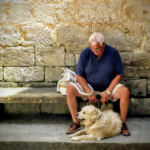







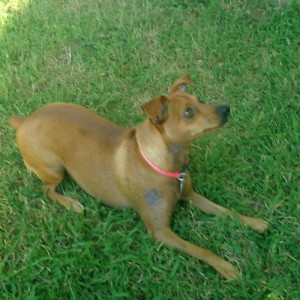
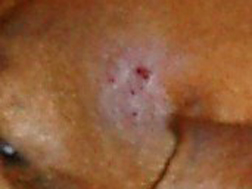
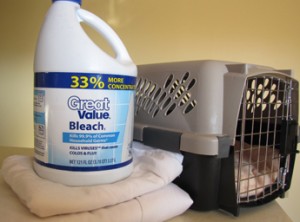

 Photo Credit:
Photo Credit: 